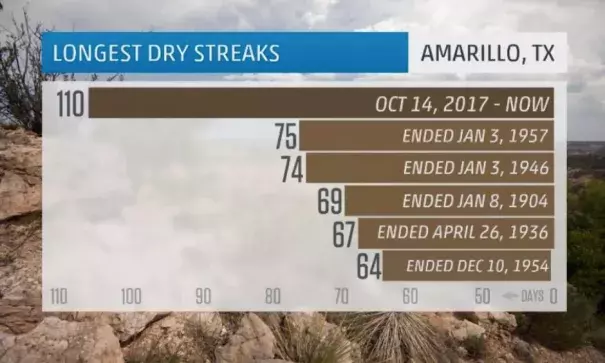Parts of Texas Have Been Drier Than Death Valley This Winter, Including a Record Dry Streak of Over 100 Days

One Texas Panhandle city has set a record dry streak, going months without significant rain or snow, and parts of the southern High Plains have been drier this winter than notoriously parched Death Valley, California.
Amarillo, Texas, hasn't picked up any measurable precipitation – at least 0.01 inches – since Oct. 13.
This streak of 110 straight dry days – nearly four straight months – through Wednesday smashed the city's previous record streak of 75 consecutive days ending in early January 1957.
It's also the first time in 127 yearsAmarillo had a completely dry November-through-January period, according to the Southeast Regional Climate Center.
They're not alone – Lubbock, Texas, also is on a dry streak that is approaching three months as of Wednesday, within a couple weeks of their record streak set in fall-winter 2005-2006.
Albuquerque, New Mexico, has also had its driest November-through-January period on record, picking up just 0.03 inches of precipitation.
Dodge City, Kansas, had its driest October-through-January period since 1927-28, when Calvin Coolidge was president.
If going months without rain or snow doesn't sound dry, consider that many locations in the southern High Plains have been drier since late-fall than Death Valley, California - 0.48 inches of precipitation from November through January - considered the hottest and driest location in the United States.
...
November through February is typically the driest time of year in the southern High Plains, including the Texas Panhandle.
In fact, February is the driest month, on average, in several locations of the Texas Panhandle and New Mexico, according to an analysis by Dr. Brian Brettschneider of the Western Regional Climate Center.
One reason winter is drier in these areas is the prevalence of strong Arctic cold fronts plunging down the High Plains – known as "blue northers" – drying out the air mass.
...
Meteorologist Chris Dolce wrote a piece just days ago suggesting this dry winter was a classic signature of La Niña, the periodic cooling of the equatorial eastern Pacific Ocean.
A December 2017 Weather Underground Category 6 blog post cited recent research suggesting the second winter of a La Niña typically features increasing drought in the Lower 48 states, particularly in the South.
Related Content



